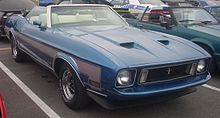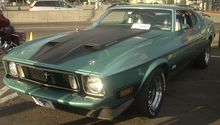- Ford Mustang Mach 1
-
Ford Mustang Mach 1 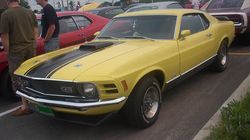
Manufacturer Ford Motor Company Production 1969–1978
2003–2004Assembly Dearborn, Michigan, United States Class Muscle car Layout FR layout The Ford Mustang Mach 1 was a performance model of the Ford Mustang that Ford produced beginning in 1969. The original production run of the Mach 1 ended in 1979 because the Mustang II coupe was being phased out in favor of newer Mustangs on the Fox body platform.
The Mach 1 returned in 2003 as a high performance version of the Mustang. The Mach 1 was discontinued again after the 2004 model year as the SN-95 platform was replaced by the newer S197 platform for the 2005 model year.
The name "mach 1" as used by Ford was originally introduced in 1959 on a concept "Levacar" originally shown in the Ford Rotunda. This concept "vehicle" utilized a cushion of air as propulsion on a circular dais. This concept vehicle was orange and white.
Contents
Introduction of the Mach 1
First generation 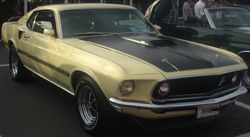
Production 1969–1973 Body style 2-door coupe Engine 1969–1970
- 351 cu in (5.8 L) Windsor- tall deck V8
- 351 cu in (5.8 L) Cleveland V8
- 390 cu in (6.4 L) V8
- 428 cu in (7.0 L) CJ/SCJ V8
- 1971–1973
The Ford Mustang was introduced in 1964 as a sporty "pony car" to attract younger buyers into Ford products. After only a few short years of development, Ford saw the need to create performance Mustangs to compete with GM and their release of the Chevrolet Camaro and Pontiac Firebird. While several performance options had existed in the form of factory 289's (from the '65s on) & factory FE engines (new for 1967 with the S-Code Engine), the vast majority of Ford Mustang's performance mantle was carried by cars modified by the legendary Carroll Shelby. 1969 was the benchmark year for Ford Mustang in its proliferation of performance names and engines. No less than 7 factory performance Mustang models were available (Boss 302, Boss 429, Shelby GT350, GT500 and the Mach 1). Additionally, nine variations of V-8s were available in the '69–'70 cars. The GT model was discontinued after 1969.(1969 GT sales had dropped to 4,973 vs 72,458 1969 Mach 1's sold.) The "GT" Mustang would not be around again until 1982 on the Fox body platform.
Ford never offererd the Mach 1 as a convertible. It was a fastback only model.
The new Mustang chassis, the last of the 1st generation models, allowed for larger engines than previous generations and could fit even the monstrous 429 for Ford's planned homologation of the engine for NASCAR competition. For Ford, the Mach 1 was introduced as an in-between model, a fit between the lower priced GT and the track oriented Boss 302s and 429s. The Mach 1 started with the fastback "Sports Roof" body and added several visual and performance enhancing items such as matte black hood with hood pins, chrome gas cap and wheels, chrome exhaust tips (except 351W 2V), and dealer optional chin and rear deck spoilers, and louvers. Standard equipment was a 351W 2V Windsor motor with a 3 speed manual transmission, and a 9" 28 spline open rear axle. A 351W 4V was optional as was a 390 4V, and the huge 428 4V Cobra Jet or with the "drag pack" option, the 428 4V Super Cobra Jet. A 4 speed manual or 3 speed FMX (small block)/C6 (big block) automatic transmission was optional, and the 428SCJ added a cast iron tailshaft in place of the regular aluminum one to the C6. A "traction lok" rear axle was optional, and the 428 CJ/SCJ included a "traction lok" with a 3.91 or 4.30 ratio, 31 spline axle shafts and a nodular case. In 1970, the 3.91 ratio was a "traction-lok", while the 4:30 ratio was a Detroit locker.
Mach 1s came with upgraded suspension to varying degrees dependent upon powertrain choices. Big block cars had front shock tower reinforcement, thicker sway bars (no rear bar for 69), and heavier springs and shocks. 428 CJ/SCJ 4 speed cars also came with staggered rear shocks. Standard on Mach 1s was a fierce but cosmetic hood scoop that had integrated turn-signal lights mounted in the back. A more functional option was the signature "Shaker hood", an air scoop mounted directly to the top of the motor, used to collect fresh air and so named for its tendency to "shake" above the rumbling V-8 below. The interior came complete with teak wood grain details, full sound deadening material and high-back sport bucket seats. The name Mach 1 could not have been more appropriate as in 1969, Performance Buyer's Digest put a new Mach 1 through its paces at Bonneville, breaking some 295 USAC speed and endurance records. Ford kept the Mach 1 alive into 1970 and little changed outside the visual. New Mach 1 specific bucket seats, Magnum 500 wheels, recessed taillights on a black honeycomb rear panel as well as new side and rear badging and striping were the main visual differences. Outselling the base GT model, Ford canceled the GT altogether to make the Mach 1 the primary street performance Mustang.
Production changes
With Ford's withdrawal from Trans-Am officially following 1970, the high end Boss 302 and 429 disappeared and were replaced by the large street-oriented Boss 351. The 1971 Mustang was larger in almost every dimension. In 1971 the Mach 1 started with a base engine of the 302ci based Windsor motor, with a 2 barrel carburetor. The lineup of engines included four 351 Cleveland engines: The 2-V, 4-V, the C.J.(Cobra Jet) and H.O.(BOSS 351). The H.O was canceled after mid-year 1971, and shortly thereafter the low-compression 351 'Cobra Jet' became available. The lineup topped out with two 429ci options, the CJ (Cobra Jet) & SCJ (Super Cobra Jet). Mach 1s, as well as all other Mustang models (except the BOSS 351) were optionally available with the CJ and SCJ motors. The SCJ came with a drag pack V or W code rear gears, oil cooler and a different rotating assembly. 429 Super Cobra Jet engines used a Holley 4-barrel carburetor, while the Cobra Jet engines made do with a GM-sourced Rochester Quadra-Jet 4-barrel carburetor.
The early version of 1971 Mustang Mach 1 (without side stripe decals) was featured in the James Bond film, Diamonds Are Forever (1971), 1973 Mach 1 named Eleanor was driven in Gone in 60 Seconds (1974)[1][2]
In 1972, the 429CJ & SCJ's were dropped from the lineup, and horsepower dropped across the board. The following year also produced the fewest Mach 1 sales of the 1971-73 generation. There are no major differences in the '71 and '72 Mustangs externally, other than different script on the trunk panel. The only difference externally on the '72 Mach 1 was the deletion of the 71-only pop-open gas cap on the Mach 1 for the standard Mustang twist-on gas cap for '72 Mach 1s. (Negative. Some early 1972 models have pop off caps. I'm 100% positive my Mach 1, built April 4th, has a pop off cap.) Apparently, the pop-open gas caps were prone to spilling fuel in a rear end collision, so Ford discontinued their use across the board. The 302 was still the base engine, with 2 barrel or 4 barrel 351 Clevelands being the only options in the Mach 1 lineup.
In 1973, the Front end was changed to fit new bumper standards, and a new Mach 1 grille was made. The Mach 1 grille in prior years had 2 "sportlamps" horizontally across the grill on the left and right side, while the functional parking lamps rode low underneath the front bumper at the outer ends of the valance panel. In 1973, all Mustang models had the sportlamps changed to a vertical orientation at each end of the grill, and these lamps served double duty as the parking lamps also. This was necessary since the new-for-73 front bumper was larger and effectively blocked the view underneath the bumper, the previous location of the parking lamps.
The rear bumper was also mounted on new bump-absorbing extensions which caused the bumper to protrude from the body about an inch farther than before. The Mach 1 graphics were also updated to a simpler, yet bolder design, which was necessitated by the change in the front bumper. Engine options remained the same as in 1972. One of the most recognizable as well as popular features of the '71-'73 block-off plates in the scoops, so it was a visual, non-functional item. However, they could be made fully functional on models ordered with the 'ram-air' option. This included vacuum controlled 'flappers' at each scoop, and a huge fiberglass underhood 'plenum' that directed cool, outside air into the carburator for increased performance. The ram-air option included a two-tone hood paint treatment in either 'matte black' or 'argent' (matte silver), coordinated to the color of the Mach 1 decals and striping. In addition, all ram-air equipped Mustangs of this generation came equipped with big twist-style chrome-plated hood lock pins.
Because of the popularity of the ram-air option, but because of the trouble getting the ram-air option approved for emissions reasons, Ford offered an 'exterior decor' option in 1973 that consisted of the two-tone paint treatment and the hood pins, but without the actual functional components of the 'ram air' system. The only engine that the functional 'ram-air' option was available on in 1973 was the 351 2-V, even though the 351 4-V 'Cobra Jet' was optional on every model.
Mustang II - Mach 1 package
Second generation Production 1974–1978 Body style 2-door coupe Engine 2.8L V6
302 cu in (4.9 L) V8Transmission 4-speed manual The Mach 1 was the performance package, fitted with the 2.8 L V6 rated at 105 hp (78 kW). The 1974 Mach 1s outsold the previous four years with the V6 in the light for its size 2,700 lb (1,200 kg) II. Next year the 302 was brought back into the Mustang, giving a much needed performance boost. At 140 hp (100 kW) and 240 lbf·ft (325 N·m) of torque, the MII was available with a 4-speed manual. It formed the top end of performance in the Mustang IIs. With 1976 came the introduction of another "performance" model, the Cobra II. In 1977 little changed but the grille of the Mustang and 1977 proved to be the lowest selling year of the Mach 1 yet, selling only 6,719 cars. It is also worth noting that four of the five years of the Mustang II are on the top-ten list of most-sold Mustangs ever. Nothing changed for 1978 other than Ford adding yet another performance model to the lineup, the King Cobra. This became the final year for the Mustang II as well as their performance models. The Mach 1 name was discontinued.
Mach 1 reborn
Ford Mustang Mach 1 New Edge 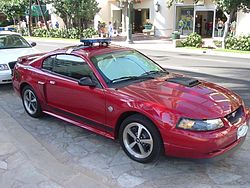
Manufacturer Ford Motor Company Production 2003–2004 Class Muscle car Body style 2-door Coupe Platform Ford Fox platform Engine 281 cu in (4.6 L) Modular DOHC 32 Valve V8 Transmission 4-speed automatic
5-speed manualWheelbase 101.3 in (2,573 mm) Length 183.2 in (4,653 mm) Width 73.1 in (1,857 mm) Height 53.1 in (1,349 mm) During the 1990s, the preeminent performance Mustang was the SVT Cobra. Following the departure of the Fox chassis in 1993 and the arrival of the SN-95 in 1994, Ford also sought to eliminate the 302. (Now marketed as 5.0 Liters; although 302 CID is closer to 4.9 L ) Drawing on its newly developed OHC architecture engines known as the Modular, SVT created the 1996 and up Cobra around several variations of the 32 valve, all aluminium 4.6 liter (281 CID) V-8. Below the SVT in performance was only the GT, reintroduced in 1982 with the 302 HO "5.0", later turning to the 16-valve SOHC V-8 in 1996. While still well behind GM competition in acceleration (the base Camaro Z-28 engine from 1993 and up made 275 hp (205 kW) and rose to 305 hp (227 kW) in 1998), the sales on the new SN-95 style cars increased, so that by 2002, Mustang sales topped the combined sales figure of the Firebird and the Camaro. With GM's withdrawal from the "Pony Car wars" in 2002, Ford had a free hand at the whole market but nonetheless created what was arguably the fastest stock Mustang up to that point in time with the 2003–2004 SVT Cobra. However, concerns over a price gap between the GT and Cobra, as well as interest in keeping sales up before the release of the all new 2005 S197 Mustang prompted the creation of two unique mid-range performance models: The 2001½ Bullitt GT and the 2003 and 2004 Mach 1 both credited to Team Mustang led by Scott Hoag.
Following the stir caused by the retro 2001 "Bullitt" (a lightly modified 2001 GT, named for the famed chase Mustang driven by Steve McQueen in the film Bullitt) Ford saw the value of heritage in the Mustang name and as a follow up, sought to revive the Mach 1 name. While similar to the Bullitt in the use of the Cobra's 13 in (330 mm) Brembo front brakes, unique Tokico gas shocks and struts, and lower and stiffer springs, the Mach 1 received a huge performance gain over the base GT and even the 265 hp (198 kW) Bullitt in the form of a unique variant of the DOHC 32-valve 4.6 Liter Modular V8. Commonly known by Mach 1 owners as an "R" code DOHC, (for the unique VIN engine R code) this all-aluminium engine features the same high flow heads as the 2003–2004 SVT Cobra, 2003–2004 Mercury Marauder, 2003–2005 Lincoln Aviator, and the 2003–2009 Australian Boss 5.4 L V8s (see Ford of Australia Boss 5.4 L), the engine also has intake camshafts sourced from Lincoln's 5.4 Liter "InTech" V8 to provide more mid-range torque. The Mach 1 engine had a 10.1:1 compression ratio in contrast to the 1999 and 2001 Cobra's 9.85:1, and the Mach 1 was equipped with a Windsor Aluminum Plant or WAP block unique from the Teksid aluminium blocks used in the 1996–1999 Cobras. The Mach 1 also featured a relatively high redline of 6,800 rpm (5-speed cars) and fuel cut off at 7,050 rpm or 5800 rpm (4-speed automatic). While on paper the 305 hp (228 kW) ratings seem a loss when compared to the 1999 and 2001 SVT Cobras which produced 320 hp (239 kW), in practice the Mach 1 engine produced similar peak horsepower and substantially more torque.
Further differences included the use of Ford's 8.8-inch (220 mm) solid rear axle with a 3.55 final ratio (As opposed to SVT's Independent Rear Suspension) also the availability of a 4 speed automatic in addition to the Tremec sourced 5 speed manual. Factory steel "Box" cross section subframe connectors were also added to increase chassis strength for both the added handling and to deal with the prodigious torque over the stock GT. Style wise, the Mach 1 was very distinct from other Mustangs as it drew heavily from the 1970 Mach 1. In addition to the matte black spoiler and hood stripe, flat black chin spoiler, Mach 1 rocker panel stripes and Mach 1 badging on the rear, there were also faux Magnum 500 polished 17x8 alloy wheels. A retro themed interior was included with well bolstered dark grey leather seats featuring 70's style "Comfort Weave" textures, a 1970s style gauge cluster and a machined aluminium shift ball. An optional 18G interior upgrade package included stainless steel pedals, a 4-Way head restraint, aluminum finished shift boot trim ring and door lock posts, and aluminium look bezels on the dash. The most noticeable difference visually from other Mustangs was the bulging hood with cut-out and the return of a semi-legitimate "Shaker Hood". While physically identical in placement and function (the scoop is said to be built on the same tooling as the 1970 Mach 1) it only provides a portion of air to the motor routing to the air box ahead of the MAF. It does function well as a cold air "snorkel" and a partial Ram Air at speed.
2004 saw only minor cosmetic changes to the Mach 1. 2004 Mach 1s can be identified by bare aluminium finished valve covers, as opposed to the 2003's black finished covers. Outside, 2004 Mach 1's wear 40th anniversary tags ahead of the doors while the 2003 has the traditional Mustang Running Pony and Tri-Color bar. The lone interior change was the deletion of the overhead "cargo net" mounted on the headliner. Despite pre-production rumors, the horsepower and torque ratings were not increased in 2004. Power rating was 305 hp (227 kW) and 320 lb·ft (434 N·m).
Unlike many limited edition cars, 2003 Mach 1 owners had a variety of stand out colors from which to choose. Originally, the cars were offered in Black, Dark Shadow Grey Metallic, Torch Red, Zinc Yellow, Oxford White and the Mach 1–only Azure Blue. In 2004 Zinc Yellow was dropped as an option and replaced with a more vibrant yellow called Screaming Yellow, as well as an all new color called Competition Orange.
With such improvements in power and a relatively light curb weight of 3,380 lb (1,533 kg), the 2003 Mustang Mach 1 posted magazine test numbers that were impressive given its $29,305 price tag. Magazine tests by Motor Trend found numbers from 13.88 seconds at 101.9 mph (164.0 km/h) for the automatic equipped 2003 Mach 1 with a 5.6 seconds 0–60 mph, up to the five speed's blistering 13.2 seconds at 106.7 mph (171.7 km/h) with a 4.7 second 0–60 mph time.[3] All this while maintaining a decent 63.5 mph (102.2 km/h) on a 600-foot (180 m) slalom and 0.85 g's on the skidpad, though the higher CG of the larger DOHC motor has created a tendency to understeer more than the IRS equipped SVTs and lower CG and lower curb weight Bullitt GTs with the same basic suspension and brakes.[4]
Limited in production, the 2003 and 2004 Mach 1s ended with the New Edge body platform, the discontinuation of the Fox framed unibody, and the introduction of the first new frame design since 1979 the s-197 with 9,652 2003's[5] and 7,182 2004's[6] being built, contrary to the Mach 1 originally being advertised as a one year limited run model with production set at 6,500 cars.[7]
Popular Mach 1 engines
- 302 ci Windsor—short deck
- Ford Boss 351 engine
- 351 Cleveland
- 351 ci Windsor—tall deck
- 428 CJ
- 429 SCJ/CJ
- Modular
References
- ^ The Bond Mustang Mach 1
- ^ Gone in 60 seconds
- ^ "2003 Ford Mustang Mach 1 - First Drive & Road Test Review". Motor Trend. 2005-02-07. http://www.motortrend.com/roadtests/coupe/112_0310_2003_ford_mustang_mach_1/index.html. Retrieved 2009-10-02.
- ^ "2003 Vortech Mustang Mach 1 - Tuners". Motor Trend. 2004-04-01. http://www.motortrend.com/features/performance/112_0404_2003_vortech_mustang_mach1/index.html. Retrieved 2009-10-02.
- ^ "TheMustangSource.com | Timeline: 2003 Mustang". Bradbarnett.net. http://bradbarnett.net/mustangs/timeline/99-04/03/. Retrieved 2009-10-02.
- ^ "TheMustangSource.com | Timeline: 2004 Mustang". Bradbarnett.net. http://bradbarnett.net/mustangs/timeline/99-04/04/. Retrieved 2009-10-02.
- ^ "FORDMUSCLE webmagazine: Feature Cars 2003 Mach 1". Fordmuscle.com. 2002-03-27. http://www.fordmuscle.com/archives/2002/03/mach1/. Retrieved 2009-10-02.
External links
Ford Mustang generations Ford in-house variants SVO · SVT Cobra · Special Service Package · California Special · Mach 1 · Boss 429 · Boss 302 · Boss 351 · Bullitt · FR500C · GT500/KR · Mustang I · Giugiaro · McLaren M813rd-party models Categories:- Ford Mustang
- Muscle cars
Wikimedia Foundation. 2010.


